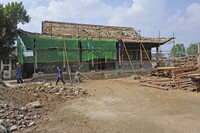Yuanjue Temple Pagoda
unknown (Chinese)

Download1A2-CH-D-SP-E1_cp.jpg (613.3Kb)
Alternative Title
圆觉寺塔
Date
1158Description
Renovation and reconstruction of a temple hall type building in the Yuanjue Temple Pagoda complex; Located in the county town of Hunyuan, Shanxi Province, the Yuanjue Temple Pagoda was first constructed in 1158 during the Jin (Golden Tartars, or Jurchen) Dynasty and underwent major repairs between 1465 and 1487 during the Ming Dynasty. The main structure, however, still belongs to the Jin (Golden Tartars) Dynasty. More than thirty meters high, the octagonal pagoda has nine levels, a typical example of multi-eared pagodas of the Jin (Golden Tartars) Dynasty. The lower part of the pagoda is a four-meter Sumeru pedestal (named after the mythic Mount Sumeru, better known as Mt. Meru) with sculptures of singers, dancers, musicians, guardians, animals and plants around the sides. The images of the singers and dancers, all in different postures, are vivid, the guardians look bold and muscular, and the lions and other animals seem true to life. The front of the first storey of the pagoda has a door with a statue of Sakyamuni inside. The iron steeple has an iron bird on top that revolves with the wind just like a weather vane, a rare example among Buddhist pagodas in the country. The temple area includes two subsidiary buildings (being restored/ rebuilt in traditional style as of 2009), one a small temple hall. Source: Cultural China; http://www.cultural-china.com/ (accessed 8/3/2012)
Type of Work
temple; pagoda (building)Subject
architecture, Restoration and conservation, Buddhism, Buddhist, Ming, Jin (Golden Tartars)
Rights
Rights Statement
Licensed for educational and research use by the MIT community only